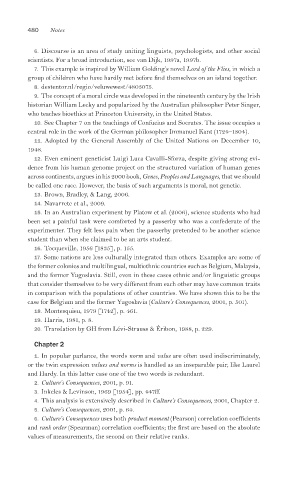Page 515 - Cultures and Organizations
P. 515
480 Notes
6. Discourse is an area of study uniting linguists, psychologists, and other social
scientists. For a broad introduction, see van Dijk, 1997a, 1997b.
7. This example is inspired by William Golding’s novel Lord of the Flies, in which a
group of children who have hardly met before find themselves on an island together.
8. destentor.nl/regio/veluwewest/4803075.
9. The concept of a moral circle was developed in the nineteenth century by the Irish
historian William Lecky and popularized by the Australian philosopher Peter Singer,
who teaches bioethics at Princeton University, in the United States.
10. See Chapter 7 on the teachings of Confucius and Socrates. The issue occupies a
central role in the work of the German philosopher Immanuel Kant (1724–1804).
11. Adopted by the General Assembly of the United Nations on December 10,
1948.
12. Even eminent geneticist Luigi Luca Cavalli-Sforza, despite giving strong evi-
dence from his human genome project on the structured variation of human genes
across continents, argues in his 2000 book, Genes, Peoples and Languages,that we should
be called one race. However, the basis of such arguments is moral, not genetic.
13. Brown, Bradley, & Lang, 2006.
14. Navarrete et al., 2009.
15. In an Australian experiment by Platow et al. (2006), science students who had
been set a painful task were comforted by a passerby who was a confederate of the
experimenter. They felt less pain when the passerby pretended to be another science
student than when she claimed to be an arts student.
16. Tocqueville, 1956 [1835], p. 155.
17. Some nations are less culturally integrated than others. Examples are some of
the former colonies and multilingual, multiethnic countries such as Belgium, Malaysia,
and the former Yugoslavia. Still, even in these cases ethnic and/or linguistic groups
that consider themselves to be very different from each other may have common traits
in comparison with the populations of other countries. We have shown this to be the
case for Belgium and the former Yugoslavia (Culture’s Consequences, 2001, p. 501).
18. Montesquieu, 1979 [1742], p. 461.
19. Harris, 1981, p. 8.
20. Translation by GH from Lévi-Strauss & Éribon, 1988, p. 229.
Chapter 2
1. In popular parlance, the words norm and value are often used indiscriminately,
or the twin expression values and norms is handled as an inseparable pair, like Laurel
and Hardy. In this latter case one of the two words is redundant.
2. Culture’s Consequences, 2001, p. 91.
3. Inkeles & Levinson, 1969 [1954], pp. 447ff.
4. This analysis is extensively described in Culture’s Consequences, 2001, Chapter 2.
5. Culture’s Consequences, 2001, p. 64.
6. Culture’s Consequences uses both product moment (Pearson) correlation coeffi cients
and rank order (Spearman) correlation coefficients; the first are based on the absolute
values of measurements, the second on their relative ranks.

